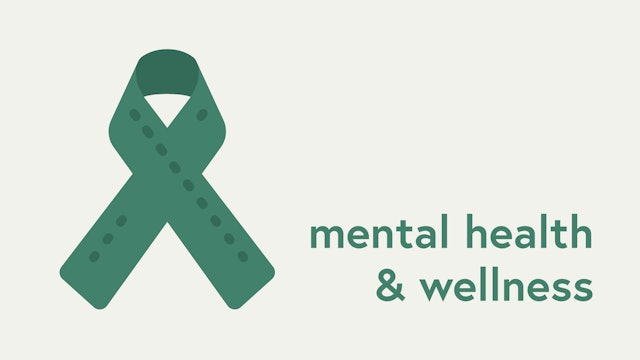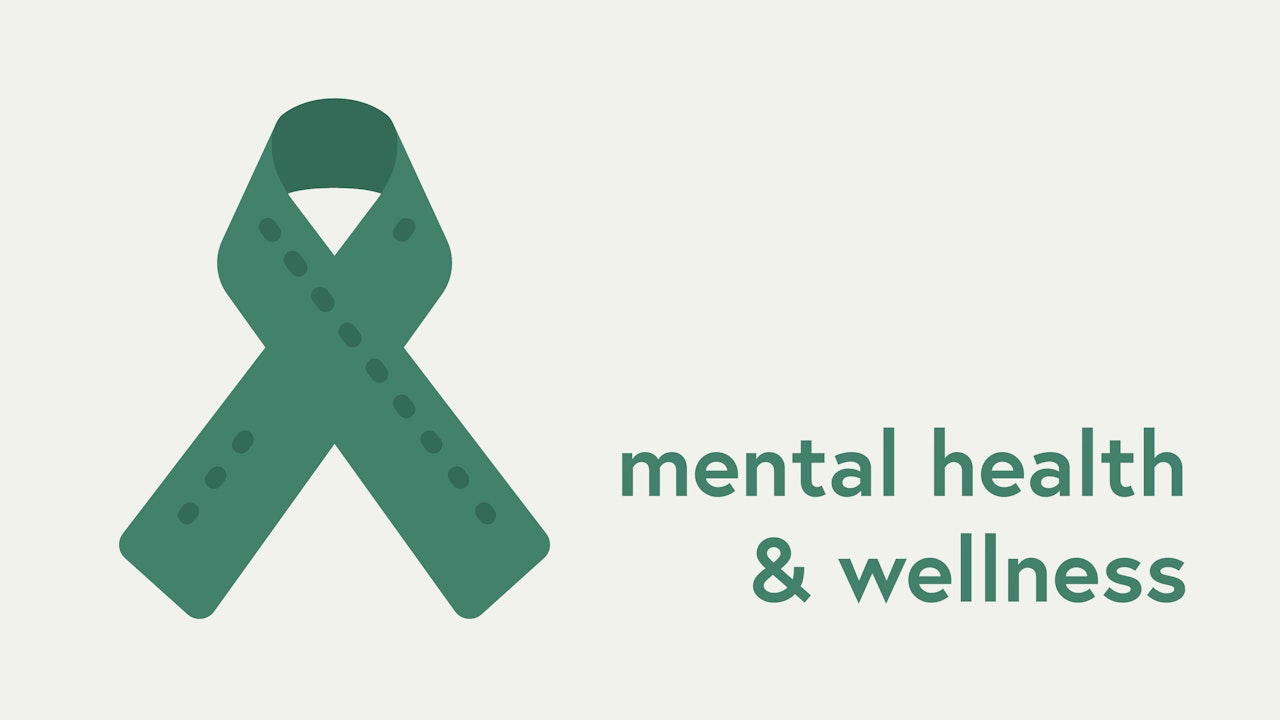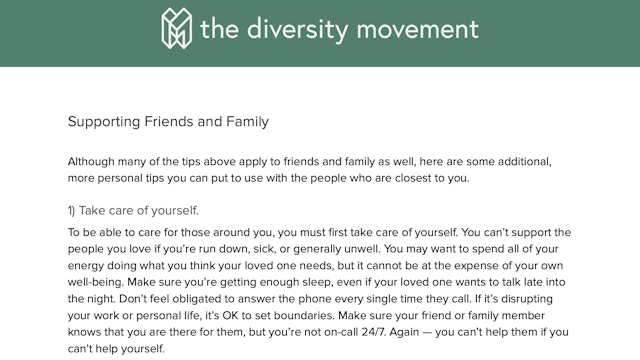-
How to Support Your Colleagues Mental Health
Move past the stigma often attached to discussing mental health issues with this helpful guidance. Learn the importance of listening to your coworkers, maintaining their confidence and trust, avoiding biased language and behaviors, and providing them with encouragement and helpful referrals.
-
How to Support Your Friend's and Family's Mental Health
Here’s an insightful list of five tips that can help you to provide helpful support to a family member or close friend with a mental health diagnosis. Confirm why it’s essential to take care of yourself first before you can be of help to others.
-
Navigating Mental Health Awareness Month
110 KB
-
Inclusive Language for Mental Health & Cognitive Diversity
Find out how to communicate inclusively when discussing mental and emotional health and neurodiversity -- the natural variations in brain functioning for learning, thinking, and processing information. Learn to recognize and avoid language that is trivializing, derogatory, or insulting.
-
What is Well-being?
Learn the general definition of well-being as well as the eight dimensions according to SAMHSA. For the full webinar, visit https://www.gotostage.com/channel/22238eff15284e69847a9bb5243d7217/recording/967d6690bf95455c823b6619bab92875/watch?source=CHANNEL
-
What is Mental Health Awareness Month?
Gain a quick overview of the prevalence of mental illness in our society, and therefore your own workforce. Learn how to address a previously taboo topic, raise awareness, and significantly reduce stigma by observing Mental Health Awareness Month in May.
-
Avoiding DEI Practitioner's Fatigue
Recognize the pitfalls of fatigue and overwhelm if you say yes to everyone’s requests in your role as a DEI practitioner. Learn how to optimize your impact as a DEI leader by staying energized, resilient, and focused on your top strategic priorities.
-
Building a Self-Care Practice
Feeling overwhelmed and overextended? Here are five helpful steps you can take to reduce your stress and boost your well-being. Learn how to reset, recharge, and build resilience with these wise suggestions for effective self-care.
-
Why Should Leaders Care About Employee Well-being?
Learn why employee well-being is a business imperative every leader should care about and how leaders can foster well-being at work.
-
Difference Between a Service Animal and an Emotional Support Animal
Get clear on the difference between service animals and emotional support animals and the ways they assist people. Benefit from helpful tips for accommodating these animals in your workplace, including what’s required by the Americans with Disabilities Act (ADA).
-
Why We Need to Talk About Well-being at Work
Learn why we must address well-being in the workplace. For the full webinar, visit https://www.gotostage.com/channel/22238eff15284e69847a9bb5243d7217/recording/967d6690bf95455c823b6619bab92875/watch?source=CHANNEL
-
Self-Care for DEI Practitioners
Recognize the reasons that the role of DEI practitioner can be emotionally draining, causing feelings of defeat and overwhelm. Learn effective ways to take care of yourself, refresh, and recharge, both every day and at especially stressful times.
-
What Should I Call Someone Who Is OCD?
Learn the respectful way to refer to someone who has obsessive-compulsive disorder, when it might be appropriate, and why you should never call someone OCD as a joke.
-
How Do You Ensure Emotional Wellness When Having a Difficult Conversation?
We are all human and conversations can be difficult no matter where we are on our DEI journey. Learn some tips on how to reset and recenter when having a difficult conversation.
-
What is Executive Dysfunction?
Understand the definition of executive dysfunction, how it impacts work performance, and what steps can be taken to empower employees who have this condition.
-
What is an Intellectual Disability?
Develop a deeper understanding of intellectual disabilities, not only how these terms are defined, but how they impact some people’s ability to reason, solve problems, plan, understand concepts, and learn.
-
What is a Toxic Workplace Culture?
A toxic workplace culture can be hard to spot from the outside, but employees know it when they’re working in one. Bullying, threats, micromanaging, and a constant feeling of uncertainty are all signals that a toxic culture may be festering.
-
How To Improve Employee Retention
Get helpful best practices for reducing employee turnover and building a loyal, cohesive workforce. Consider factors that employees value beyond salary and benefits alone. Discover why an inclusive company culture helps retain employees for the long term.
-
Why Leaders Should Care About Mental Health at Work
Learn why mental wellness at work is a business imperative that every leader should prioritize. For the full webinar, visit
https://www.gotostage.com/channel/22238eff15284e69847a9bb5243d7217/recording/967d6690bf95455c823b6619bab92875/watch?source=CHANNEL -
What is Mansplaining and How to Avoid It
Discover the meaning of the term “mansplaining.” Learn why this way of communicating makes employees on the receiving end feel disrespected and creates a toxic company culture. Learn best practices for addressing and eliminating mansplaining behavior in your organization.
-
What is the Great Resignation?
Consider why Americans are quitting their jobs in record numbers in the wake of the COVID-19 pandemic. Learn valuable best practices for building an inclusive, supportive, and flexible culture that will reduce employee turnover at your company.
-
What are the Costs of a Negative Workplace Culture?
Negative workplace cultures take a toll on the health and well-being of all employees, and the financial success of the business. Let’s explore a few costs associated with toxic workplaces and how to avoid them.
-
What is Toxic Masculinity?
Toxic masculinity is associated with a winner-take-all mentality, emotional toughness, physical stamina, and sabotaging colleagues or coworkers to get ahead. This video will help you understand the meaning of this phrase and why it matters in the workplace.
-
How Leaders Can Take Care of Themselves
As a leader, you need to support yourself before you can support others. Learn strategies to take care of your well-being. For the full webinar, visit https://www.gotostage.com/channel/22238eff15284e69847a9bb5243d7217/recording/967d6690bf95455c823b6619bab92875/watch?source=CHANNEL


























